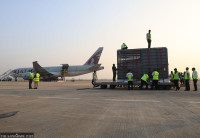Lumbini Province
Wildlife in Banke, Bardiya national parks affected as water sources dry up
Parched animals enter human settlements in search of water that leads to human-wildlife conflict.
Thakur Singh Tharu & Kamal Panthi
Wildlife in Banke and Bardiya national parks have been hugely affected due to the drying up of water sources in the protected areas. The scarcity of water has led to more animals entering human settlements in search of water and causing human-wildlife conflict.
Banke National Park, which spreads across 550 square kilometres of area, does not have perennial rivers and rivulets that pass through the protected region.
“There are a few streams that pass through the park forests but water level there sharply decreases during the dry season,” said Shyam Shah, the chief conservation officer at the Banke National Park.
To address the water issue, the national park a few years ago had constructed around four dozen artificial ponds in the park area. According to the park administration, there are around 100 natural and artificial water sources within the park area but almost all of them run dry during the dry season.
“Wild animals from the park come out and enter human settlements due to water shortage. It is one of the reasons behind the unchecked incidents of human-animal conflict,” said Shah.
Frequent road accidents involving wildlife are reported along the East-West Highway, as the animals in the park have to cross the highway to reach Rapti River, which lies in the buffer zone area.
A 102-km stretch of the highway passes through the park. To avoid human-wildlife conflict and reduce the number of road accidents involving wildlife, park authorities have constructed ponds in the park area so the animals don’t have to cross the highway to reach Rapti River.
Artificial ponds have been constructed in Giddhenichaur, Bikasnagar, Khadkawar and Navapratibha, among other areas of the park.
“It is necessary for park authorities to manage water for wild animals all year round. Animals start entering human settlements when there’s no water source inside the park,” said Krishna Chaudhary, a conservationist in Banke. “The park should lift water from Babai and Rapti rivers to save wild animals.”
Banke National Park is home to 21 tigers along with wild elephants, deer and spotted deer, among other animals.
Bardiya National Park also has a similar problem. A sharp decline in the water flow in Geruwa river, an offshoot of the Karnali River a few kilometres downstream from Chisapani, has affected wildlife in the western part of the national park.
“The park forest along the Geruwa river banks is the habitat of several wildlife, including tiger, rhino, elephant and spotted deer. The animals enter human settlements in the dry season, as the river hardly has any water,” said Rangilal Tharu of Geruwa Rural Municipality-4. “Wildlife menace in the area can be contained if the authorities manage water for park animals.”
Over the past few years, Geruwa River has been gradually changing its course from the main stream of Karnali. As a consequence, the water flow has declined sharply, as floods in the past have deposited too much silt at Lalmatiya. The local people and conservationists are demanding authorities to channelise water in the Geruwa river by removing the siltation.
Asim Thapa, assistant conservation officer of the park, however, said that the park administration is working to manage water in Geruwa River.
“We have constructed 52 artificial ponds and installed 45 solar water pumps for the management of water for wildlife,” Thapa said.
But locals say the park’s efforts are not sufficient. Mohammad Kar Khan, a member of the secretariat of the Federation of Community Forestry Users Nepal, said the park authorities should work more efficiently to manage water for its animals to contain human-wildlife conflict.
Bardiya National Park, which spreads across 968 sq km of area, is home to an estimated 125 tigers along with rhinos, wild elephants, swamp deer and black buck, among other animals.




 16.12°C Kathmandu
16.12°C Kathmandu













